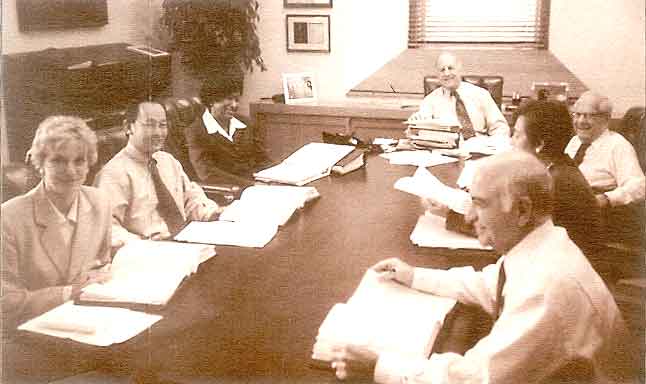
Internal
Operating Practices and Procedures of the California Supreme Court
(Revised January 22, 1997)
(Revised January 22, 1997)
The following internal operating practices and procedures
are observed by the California Supreme Court in the performance of its
duties.
![]() IV.
CONFERENCE MEMORANDA
IV.
CONFERENCE MEMORANDA
-
Unless otherwise directed by the Chief justice, a conference memorandum is prepared for each petition requiring conference consideration or action.
-
Upon the filing of a petition, motion, or application, the Calendar Coordinator, under the direction of the Chief Justice, assigns it a conference date and refers it to one of the central staffs or a member of the court for prepara- tion of a conference memorandum as follows:
1. Petitions in or derived from criminal cases, to the criminal central staff.
2. Applications for writs of habeas corpus arising out of criminal proceedings, to the criminal central staff.
3. Petitions for review of State Bar proceedings pursuant to rule 952 et seq. of the California Rules of Court and applications to the Supreme Court pursuant to article V, section 8 of the California Constitution for a recommendation regarding the granting of a pardon or commutation to a person twice convicted of a felony, to the criminal central staff.
4. Petitions in civil cases, to the civil central staff.5. All other petitions and applications, including overflow petitions that cannot be handled by the existing central staffs, to the six associate ustices and the Chief Justice in rotation so that, at the end of a given period of time, each justice will have been assigned an equal number of petitions. Petitions for rehearing after decision in the Supreme Court are referred to a justice, other than the author, who concurred in the majority opinion. -
The recommendation set forth in a conference memorandum will generally be one of the following: (1) 'Grant," (2) 'Grant and Hold," (3) "Grant and Transfer,' (4) "Deny,' (5) 'Submitted,' (6) 'Denial Submitted," and (7) 'Deny and Depublish." The designation "submitted" is used when the author believes the case warrants special discussion. The designation "denial submitted" is used when the author believes the petition should be denied, but nevertheless believes some ground exists that could arguably justify a grant, or an issue is raised that otherwise warrants discussion by the court. The designation 'deny and depublish' is used when the author does not believe the decision warrants review, but nevertheless believes the opinion is potentially misleading and should not be relied on as precedent. (Note: the California Supreme Court, and its Staff Attorneys, repeatedly failed to follow specific U.S. Supreme Court ruling on habeas corpus petitions. If they had followed Federal Rules on habeas corpus petitions, the California Supreme Court would have vacated San Francisco Judge Kevin Ryan's illegal 16 years-to-life sentence imposed on Steven Nary.)
-
The author of the conference memorandum assigns it to either the 'W' or the "B" list. Cases assigned to the 'T list include all those in which the rec- ommendation is to grant or take affirmative action of some kind, e.g., 'grant and transfer" or "deny and depublish,' or in which the author believes denial is appropriate, but that the case poses questions that deserve special atten- tion. Cases assigned to the 'B' list concern routine matters, or application of settled law.
-
Conference memoranda are delivered by the author to the Calendar Coordinator for reproduction and distribution to the justices no later than the Tuesday of the week before the conference, thus providing ample time for the justices and their staffs to review the petition and the court's internal memoranda.
-
The court's calendar coordinator divides the weekly conference agenda into an 'A' and 'B' list, based on the designation appearing on each conference memorandum.
-
Matters appearing on the 'A7 list are called and considered at the con- ference for which they are scheduled. Before or after a vote is taken, any justice may request that a case be put over to a subsequent conference within the jurisdictional time limit for further study, preparation of a supplemental mem- orandum, or both. The time within which action thereon must be taken will be extended pursuant to rules 24 and 28 of the California Rules of Court, if necessary.
-
Matters appearing on the "B" list will be denied in accordance with the recommendation of the memorandum, at the conference at which they are scheduled, unless a justice requests that a case be put over to a subsequent conference within the jurisdictional time limit for further study, preparation of a supplemental memorandum, or both.
-
In any case in which the petition, application, or motion is denied, a jus- tice may request that his or her vote be recorded in the court minutes.
-
When a justice is unavailable or disqualified to participate in a vote on a petition for review or other matter and four justices cannot agree on a disposi- tion, the Chief Justice, pursuant to constitutional authority (Cal. Const., art. VI, § 6), assigns on a rotational basis a Court of Appeal justice as a pro tempore justice to participate in the vote on the petition or matter. The assigned jus- tice is furnished all pertinent petitions, motions, applications, answers, memoranda, and other material.
